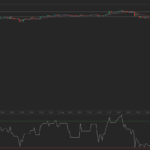 On Tuesday, the Japanese yen, having hit 6-month lows against the US dollar yesterday on BoJ Governors statement, reached a new 6-month bottom. The yen depreciated the most against the US dollar since May 23rd on reinforced speculation of earlier-than-expected Fed tapering.
On Tuesday, the Japanese yen, having hit 6-month lows against the US dollar yesterday on BoJ Governors statement, reached a new 6-month bottom. The yen depreciated the most against the US dollar since May 23rd on reinforced speculation of earlier-than-expected Fed tapering.
USD/JPY hit a session high at 103.38 at 4:35 GMT, which is the highest level since May 23rd. At 08:15 GMT the pair is trading near 6-month highs to trade at 103.11, gaining 0.17% for the day. Support is likely to be received at December 2nd low, 102.23, while resistance is to be encountered at May 23rd high, 103.56.
Yesterday, the Institute for Supply Management (ISM) published the results of its survey, which are reflected by the manufacturing PMI index. The ISM manufacturing index rose to 57.3 in November, the highest since April 2011 and compared to a reading of 56.4 the previous month. The result outstripped analysts forecast of 55.1.
Yuji Kameoka, chief currency strategist in Tokyo at Daiwa Securities Co., cited by Bloomberg, said: “U.S. data is going to keep driving the direction of the dollar, yesterday’s numbers have boosted the view that tapering could happen in December.”
The dollar strengthened 4.1% this year against a basket of nine other developed-nation currencies tracked by Bloomberg Correlation-Weighted Indexes, while the yen, tracked by the same indexes was the worst performer, having lost 14%.
ADP Research Institute is expected to publish tomorrow a report on the newly developed non-farm positions in US companies. The report will probably say that companies in the U.S. added 170,000 positions in November, which would be the highest level in five months,
Another report due tomorrow will probably show that non-manufacturing index by the ISM, continued to expand.
Jobless claims and payrolls figures are due later this week.
“While the U.S. data continue to print better, the dollar will be supported, there’s a view in the market that the Fed might taper in December.”, said Yuki Sakasai, a foreign-exchange strategist at Barclays Plc. in New York, cited by Bloomberg.
Next policy meeting of the Fed officials will be held on 17-18th of December. Speculation mounted that Fed may taper its bond-purchasing program, worth $85 billion per month, as on November 20th Fed minutes pointed a probable cut in Fed stimulus “in coming months”, if the economy moves in the right direction.
According to the US Commodity Futures Trading Commission (CFTC) figures, investors boosted bets on a slide in the yen to 123,202, the most since July 2007.
Meanwhile, a Japanese report on Average Cash Earnings in October revealed a 0.2% gain for the month, compared to the same period a year ago. The previous value of the indicator was downwardly revised from 0.1% gain, to a negative 0.2%. Average Cash Earnings actually measure the change in employment income, including bonuses and overtime pay. Higher income is positive for consumption.
Another report showed that the Japanese monetary base increased in November compared to the same period a year ago, to reach 52.5%. Last year the monetary base stood at 45.8%, while projections were pointing a level of 47.2% in November. Monetary Base measures the change in the total amount of domestic currency in circulation and current account deposits held at the BoJ. An increasing supply of money leads to additional spending, which in turn leads to inflation.
On Monday, the Japanese Finance Ministry reported that capital spending rose 1.5% in the third quarter, from a year earlier. The indicator calls for the change in the value of the new capital expenditures made by the business during the present quarter, compared to the same quarter the previous year. Capital spending is a key indicator for economic growth and is a fundamental part of the GDP. When capital expenditures rise, there are signs of corporate growth, which drives Japanese economic growth.
Meanwhile, BoJ Governor Haruhiko Kuroda, cited by Bloomberg, said on Monday in the city of Nagoya that the central bank will continue easing monetary policy until the 2% inflation rate becomes stable and will monitor the impact of the yen’s correction on small companies.
Japan is in a process of recovery after the 15-year period of deflation. Bank of Japan has been purchasing more than 7 trillion JPY (68.4 billion USD) of government bonds each month in its struggle to achieve 2% inflation in two years since April.
Capital spending increases and monetary base expands, which indicates that the Japanese government and BoJ policymakers are making steps in the right direction to achieve the target of a 2% inflation rate during late 2014, or early 2015.
Elsewhere, AUD/USD reached a session low at 0.9058 at 4:35 GMT, after which consolidation followed at 0.9073, falling 0.36% for the day. Support was likely to be received November 29th low, 0.9056, while resistance was to be seen at December 2nd high, 0.9168. AUD/NZD pair was falling 0.11% today to trade at 1.1118 at 7:58 GMT, after reaching its lowest point since October 2008 at 1.1105 on Monday.





